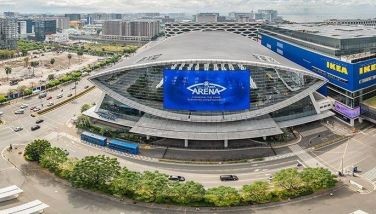Treadmill: Running to stay in place
December 19, 2006 | 12:00am
The 15th Asian Games in Doha, Qatar ended last Friday at the Khalifa Stadium in a blaze of glory before some 40,000 spectators and a television audience estimated at around three billion. For the host nation Qatar and for the Middle East, the Games provided an opportunity for the Arabs to help manage the perception about the region and its people and to showcase its progress in sports. It also underscored Qatar’s intention to bid for the 2016 summer Olympic Games.
For China, the Games were the last Olympic-style regional meet for it prior to hosting the 2008 Beijing Olympics in August and a chance to stamp its class in the region. At the end of the Doha games, China was way ahead in the medal standings with 165 gold medals, up by 15 from what it won in Busan, Korea four years ago.
Although in many instances in Doha the Chinese found competition wanting, their victories nonetheless helped prep up the entire nation for 2008 as it made no secret of its desire to dominate the forthcoming Olympics. China is obviously casting a moist eye on the overall championship which the United States has won over several Olympics. But that is getting ahead of the story.The real winners in the Games are the Arab nations led by Iran and Qatar and three Southeast Asian countries, namely, Thailand, Malaysia and Singapore. All these countries landed in the top 12 among 45 nations that competed in Doha.
The progress made by the Arab nations in sports despite the turmoil in the Middle East should be watched very closely. It provides an indication of how such nations view sports and physical fitness: that it is an integral part of the overall development of a country and helps create a positive image in the international community.
Even North Korea, which together with Iran and other nations, has been called by the United States unflattering names, realizes the value of sports as a propaganda tool and does its best in international competitions. Certainly, international sports is a medium for making political statements, notwithstanding the cries of sports traditionalists and purists of insulating or separating sports from politics.
Iran finished sixth, winning 11golds, 15 silvers and 21 bronzes. Qatar pocketed 8 golds, 11 silvers and 11 bronzes. Thailand, which trailed us badly in the 2005 Southeast Asian Games (SEA Games) in Manila in December, bagged fifth place overall doing 13-15-26 for a total of 54 medals. Malaysia came in 10th and second among the Association of Southeast Asian Nations (ASEAN) countries with 8-17-17. But the most interesting performance was produced by tiny city-state Singapore which landed 12th overall in the Games and third among SEA Games countries with 8-7-12 or double the four gold medals of the Philippines.
The Philippine performance can be viewed from varied perspectives. From the positive end, one can say with justifiable pride that its 4-6-9 clip was the best in 44 years. In the 1962 Jakarta Asiad, the Philippines had a medal haul of 7-4-16. In the 2nd Asian Games in 1954 held in Manila, the country captured 14 golds, 14 silvers and 17 bronzes followed by 8-9-21 in Tokyo in 1958.
If one were to be guardedly optimistic, one has to say all these achievements were of course made when China was in virtual seclusion, battling poverty and just recovering from a civil war that saw breakaway Republic of China being formed. Except for Lebanon and Israel, most of the countries in the Middle East were fledgling governments addressing basic issues like food and national security in the fragile region.
In Southeast Asia, Singapore was not even a sovereign country at that time, it being part of the Federation of Malaya that eventually became Federal Republic of Malaysia. Thailand too was behind the Philippines in terms of Gross Domestic Product and Gross National Product yardsticks.
Over the years however, especially in the late ‘60s, these countries buckled down to work and got their acts together and came up with a national vision that their stakeholders embraced. The formulation of a vision seeped down to the different sectors with the latter coming up with their own sector visions. Sports and physical fitness was one such sector. Thus, all three countries produced their respective master plans for sports.
In our case, we have been distracted all these years by unproductive bickering and politicking to the point that even the relatively simple job of updating the Master Plan for Sports (1996 — 2000) has to proceed at a much faster pace. If we delay any further, we might end up being overtaken by Cambodia or one of those other Southeast Asian countries that not only did not win a single medal in the Asian Games but was also hard pressed to win a gold medal in the lower tier SEA Games.
The tragedy of our situation is that everything is in place and waiting for us to organize ourselves so that we can make use of our biggest asset: our people.
As I have said before, the framework for an effective physical education and sports system is essentially in place. What we need is to follow the correct path but first we have to define that path through a road map. The road map, through the Master Plan, is waiting to be updated.
The framework includes, among others, Republic Act 6847 (which created the Philippine Sports Commission (PSC) during the administration of President Corazon C. Aquino), Executive Orders 63 and 64 signed by President Fidel V. Ramos, the Philippine Olympic Committee and the strategic plan of the PSC.
As I have also stated in the past, the framework is hardly being used. Significantly, more work could be done at the mass based sports level through the National Physical Fitness and Sports Development Council (NPFSDC) that was created under Executive Order during President Ramos’ time. The NPFSDC can be more active in coordinating by looking to training opportunities that are available to school teachers and other relevant sports coordinators and by working towards a philosophy that looks to offer PE (Physical Education) and sports education to all children and not just the talented.
I suspect that one of the reasons for the non-use of the framework is that we want immediate gratification through crash programs. The use of the framework will involve drab and unexciting work involving rural communities as opposed to dealing with elite athletes who make good copy.
There is no shortcut to national development. The effort at long term sports development will have to be built block by block. If we are to be taken seriously by others, we will have to produce a plan and make it alive.
Spending so much time and resources on sports development without a plan is like building a castle or, to be more modest, a house without the plumbing, architectural and other essential plans and the bill of materials. It’s like being on a treadmill: running just to stay in place.
For China, the Games were the last Olympic-style regional meet for it prior to hosting the 2008 Beijing Olympics in August and a chance to stamp its class in the region. At the end of the Doha games, China was way ahead in the medal standings with 165 gold medals, up by 15 from what it won in Busan, Korea four years ago.
Although in many instances in Doha the Chinese found competition wanting, their victories nonetheless helped prep up the entire nation for 2008 as it made no secret of its desire to dominate the forthcoming Olympics. China is obviously casting a moist eye on the overall championship which the United States has won over several Olympics. But that is getting ahead of the story.The real winners in the Games are the Arab nations led by Iran and Qatar and three Southeast Asian countries, namely, Thailand, Malaysia and Singapore. All these countries landed in the top 12 among 45 nations that competed in Doha.
The progress made by the Arab nations in sports despite the turmoil in the Middle East should be watched very closely. It provides an indication of how such nations view sports and physical fitness: that it is an integral part of the overall development of a country and helps create a positive image in the international community.
Even North Korea, which together with Iran and other nations, has been called by the United States unflattering names, realizes the value of sports as a propaganda tool and does its best in international competitions. Certainly, international sports is a medium for making political statements, notwithstanding the cries of sports traditionalists and purists of insulating or separating sports from politics.
Iran finished sixth, winning 11golds, 15 silvers and 21 bronzes. Qatar pocketed 8 golds, 11 silvers and 11 bronzes. Thailand, which trailed us badly in the 2005 Southeast Asian Games (SEA Games) in Manila in December, bagged fifth place overall doing 13-15-26 for a total of 54 medals. Malaysia came in 10th and second among the Association of Southeast Asian Nations (ASEAN) countries with 8-17-17. But the most interesting performance was produced by tiny city-state Singapore which landed 12th overall in the Games and third among SEA Games countries with 8-7-12 or double the four gold medals of the Philippines.
The Philippine performance can be viewed from varied perspectives. From the positive end, one can say with justifiable pride that its 4-6-9 clip was the best in 44 years. In the 1962 Jakarta Asiad, the Philippines had a medal haul of 7-4-16. In the 2nd Asian Games in 1954 held in Manila, the country captured 14 golds, 14 silvers and 17 bronzes followed by 8-9-21 in Tokyo in 1958.
If one were to be guardedly optimistic, one has to say all these achievements were of course made when China was in virtual seclusion, battling poverty and just recovering from a civil war that saw breakaway Republic of China being formed. Except for Lebanon and Israel, most of the countries in the Middle East were fledgling governments addressing basic issues like food and national security in the fragile region.
In Southeast Asia, Singapore was not even a sovereign country at that time, it being part of the Federation of Malaya that eventually became Federal Republic of Malaysia. Thailand too was behind the Philippines in terms of Gross Domestic Product and Gross National Product yardsticks.
Over the years however, especially in the late ‘60s, these countries buckled down to work and got their acts together and came up with a national vision that their stakeholders embraced. The formulation of a vision seeped down to the different sectors with the latter coming up with their own sector visions. Sports and physical fitness was one such sector. Thus, all three countries produced their respective master plans for sports.
In our case, we have been distracted all these years by unproductive bickering and politicking to the point that even the relatively simple job of updating the Master Plan for Sports (1996 — 2000) has to proceed at a much faster pace. If we delay any further, we might end up being overtaken by Cambodia or one of those other Southeast Asian countries that not only did not win a single medal in the Asian Games but was also hard pressed to win a gold medal in the lower tier SEA Games.
The tragedy of our situation is that everything is in place and waiting for us to organize ourselves so that we can make use of our biggest asset: our people.
As I have said before, the framework for an effective physical education and sports system is essentially in place. What we need is to follow the correct path but first we have to define that path through a road map. The road map, through the Master Plan, is waiting to be updated.
The framework includes, among others, Republic Act 6847 (which created the Philippine Sports Commission (PSC) during the administration of President Corazon C. Aquino), Executive Orders 63 and 64 signed by President Fidel V. Ramos, the Philippine Olympic Committee and the strategic plan of the PSC.
As I have also stated in the past, the framework is hardly being used. Significantly, more work could be done at the mass based sports level through the National Physical Fitness and Sports Development Council (NPFSDC) that was created under Executive Order during President Ramos’ time. The NPFSDC can be more active in coordinating by looking to training opportunities that are available to school teachers and other relevant sports coordinators and by working towards a philosophy that looks to offer PE (Physical Education) and sports education to all children and not just the talented.
I suspect that one of the reasons for the non-use of the framework is that we want immediate gratification through crash programs. The use of the framework will involve drab and unexciting work involving rural communities as opposed to dealing with elite athletes who make good copy.
There is no shortcut to national development. The effort at long term sports development will have to be built block by block. If we are to be taken seriously by others, we will have to produce a plan and make it alive.
Spending so much time and resources on sports development without a plan is like building a castle or, to be more modest, a house without the plumbing, architectural and other essential plans and the bill of materials. It’s like being on a treadmill: running just to stay in place.
BrandSpace Articles
<
>
- Latest
- Trending
Trending
Latest
Trending
Latest
Recommended


































